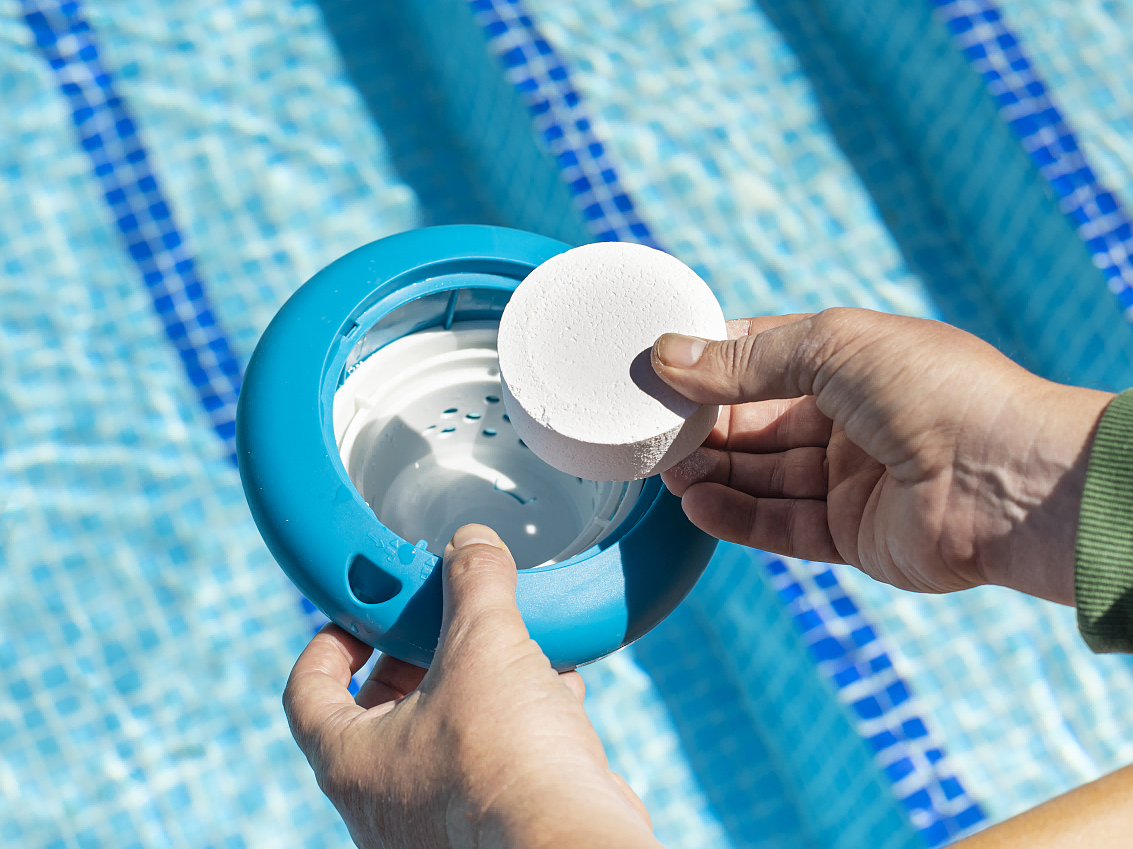Part 1: Calcium Hypochlorite (Cal-Hypo) as a Pool Disinfectant
- What is Calcium Hypochlorite?
Calcium Hypochlorite (Ca(ClO)₂) is a white, solid chemical compound sold in granular or tablet form. It is a powerful oxidizer and a highly effective chlorine-based disinfectant, sanitizer, and algaecide. It’s commonly known as “pool shock” or “cal-hypo shock.” - Key Properties & Advantages
High Chlorine Content: Typically contains 65-75% available chlorine, making it one of the most potent chlorine sources available.
Fast-Acting: It works quickly to destroy bacteria, viruses, and algae, and to oxidize (break down) organic contaminants like sweat, urine, and leaves.
Adds Calcium Hardness: As it dissolves, it increases the pool water’s calcium hardness (CH) level. This is beneficial for pools with soft water (low CH), as it prevents corrosion of plaster, tile grout, and metal fixtures.
Stability: In its dry, solid form, it has a long shelf life if stored properly in a cool, dry place.
Inexpensive: It is generally a cost-effective method for shocking a pool. - Important Considerations & Safety Warnings
Incompatibility with Other Chemicals: This is critical. Cal-hypo must NEVER be mixed with other pool chemicals, especially:
Trichloroisocyanuric Acid (Trichlor)
Dichloroisocyanuric Acid (Dichlor)
Mixing these dry chemicals can cause a violent fire or explosion. Always add chemicals to the pool separately.
Can Raise Calcium Hardness Too High: For pools with already high calcium hardness, using cal-hypo can push levels beyond the recommended range (typically 200-400 ppm). This can lead to calcium scaling, making the water cloudy and causing a rough, white crust to form on pool surfaces, filters, and equipment.
Not for Regular Chlorinators: Cal-hypo tablets are not designed for use in standard trichlor tablet feeders (skimmers or inline chlorinators), as they dissolve differently and can create dangerous pressure buildup.
Safety Gear: Always wear safety glasses and chemical-resistant gloves when handling.
Part 2: The Suspension Dosing Device
- What is it?
This is a simple but essential tool designed specifically for the safe and effective application of granular cal-hypo.
A suspension dosing device is a perforated container, usually made of plastic, that holds the dry chemical. It is attached to a pole (like a pool skimmer or brush pole) and suspended in the pool water. Common names include: - Why is it Necessary? (The Critical Purpose)
The primary reasons for using this device are Safety, Pool Surface Protection, and Equipment Protection.
Prevents Damage to Pool Surfaces: Cal-hypo if poured directly into the pool, it will sink to the bottom before fully dissolving. The intense concentration of chlorine can bleach and degrade vinyl liners and etch or stain plaster and fiberglass surfaces, causing permanent damage.
Ensures Even Distribution: By suspending the chemical in the water, it dissolves gradually and circulates throughout the pool as it’s released, providing a more uniform and effective disinfection.
Enhances Safety: It keeps the undissolved chemical contained and away from people in the pool, preventing accidental contact with skin or eyes. - How to Use a Suspension Dosing Device?
Preparation: Put on your safety glasses and gloves. Ensure the pump is running to ensure good circulation.
Fill the Container: Place the measured dose of cal-hypo granules into the device according to your pool’s volume and the manufacturer’s instructions on the chemical label.
Secure the Lid: Close the container tightly.
Suspend in the Pool: Attach the device to your pool pole and lower it into the deep end of the pool. Ensure it is fully submerged and hanging freely, not resting against the pool wall or floor.
Always Use a Dispenser: Never broadcast or pour cal-hypo granules directly into the pool. The suspension device is a non-negotiable safety tool.
Test Your Water: Always test your pool water’s Free Chlorine (FC), pH, and Calcium Hardness (CH) before adding cal-hypo. This prevents over-chlorination and scaling issues.
Add at Dusk/Night: For maximum effectiveness, shock the pool in the evening. Sunlight (UV rays) degrades chlorine, reducing its potency.
By understanding the properties of Calcium Hypochlorite and using a proper suspension dosing device, you can effectively and safely maintain a clean, clear, and healthy swimming pool.









